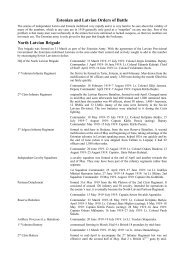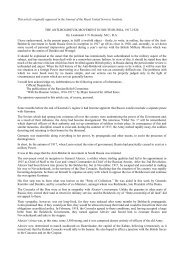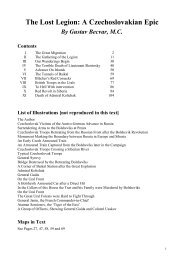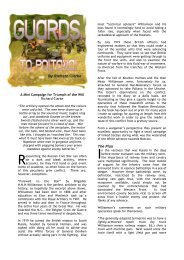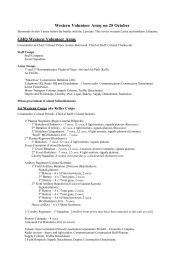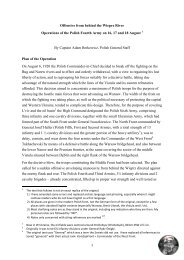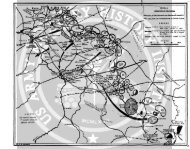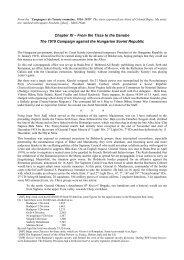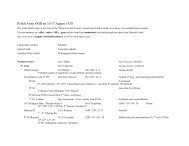Create successful ePaper yourself
Turn your PDF publications into a flip-book with our unique Google optimized e-Paper software.
Definitions<br />
Each inch represents about 25 metres. A table-top move represents 5 minutes.<br />
A base has a frontage of 30mm and enough depth to fit the figures. It represents<br />
• Between 20–50 riflemen or sabres;<br />
• A handful of machine-guns either on foot or on horse carriages (called tachankas);<br />
• Two guns (or one, if a base is only 20 rifles);<br />
• An armoured car or tank; or<br />
• An officer with a few staff.<br />
Infantry includes riflemen, engineers and machine-gunners. Cavalry includes sabre and tachanka bases. Sabres is any<br />
cavalryman prepared to fight, armed with any or all of: sabres, lances, carbines and pistols. Artillery includes mortars<br />
and canons and their limbers. Vehicles includes tanks, armoured cars and trains.<br />
Riflemen and sabres form units of 2 to 6 bases of the same sort which act together, commanded by a junior officer.<br />
Other troops types normally operate independently, but MGs, artillery and tachankas may form units of up to 4 bases of<br />
the same sort acting together, either with or without a junior officer.<br />
Junior officers are represented by tokens attached to the unit they command, from which they may not separate. They<br />
are in turn commanded by senior officers, one of whom is the commanding general, represented by independent bases.<br />
Soviet players may prefer to insist that they have no officers, only “Red commanders”.<br />
Senior officer bases operating independently are separate units. They require an action segment to move and can be shot<br />
at if target priorities are applicable and they are clearly distinct from other units.<br />
Soviet and Partisan armies, except Konnarmiya and Latvians, draw two officer tokens randomly for each senior officer<br />
and select one of them. Other armies draw three tokens for each senior officer and then select one. Afterwards both<br />
sides draw one token randomly for each junior officer.<br />
A unit action is any movement, shooting or change of status by the owner of the unit or which arises as a result of a<br />
morale test or shooting or combat result. Voluntary actions by a player occur during a unit’s action segment.<br />
A turn is a series of action segments, one for each unit on the table.<br />
Unit types and officers can have characteristics which affect morale and abilities.<br />
A unit accumulates terror markers as the game progresses, and when these exceed the number of bases in the unit, the<br />
unit immediately routs. They also reduce the effective number of bases in the unit. They are removed by a rally from<br />
terror action. A humiliated marker is a regarded as a terror marker than cannot be removed and all references to the<br />
number of terror markers on a unit includes the humiliated markers.<br />
A pinned marker can be placed on a unit as a shooting result. This prevents movement towards the enemy until a<br />
successful rally from pinned test is made.<br />
The effective number of bases for shooting and combat is the actual number less one for each terror marker. If the<br />
number of terror markers equals the number of bases, then one half of one base is counted.<br />
Each army has a flight numbers, shown as a percentage. Multiply this percentage against a side’s original point total<br />
and determine how many points worth must be destroyed, captured, or routing to exceed the flight number.<br />
Game Sequence<br />
1) Determine which player is attacking.<br />
2) Draw officer tokens (see above).<br />
3) A defender notes any ambushes, and then places position markers which indicate the position of the nonambushing<br />
troops on the table.<br />
4) The attacker moves any or all of his troops 100m (4") onto the table at his entry points and notes the entry point<br />
of any reinforcement units.<br />
5) The agreed number of turns is then played, stopping if either army reaches it flight number.<br />
Dummy position markers may be used by agreement. An attacker may use unit position markers too, if only to speed<br />
play. Markers are revealed as figures when they become visible to any enemy or fire.<br />
The attacker may move reinforcement units onto the table at any time in a move.<br />
October 2006 2



